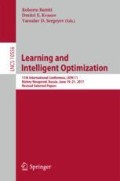Abstract
Business Rules programs encode decision-making processes using “if-then” constructs in a way that is easy for non-programmers to manipulate. A common example is the process of automatic validation of a loan request for a bank. The decision process is defined by bank managers relying on the bank strategy and their own experience. Bank-side, such processes are often required to meet goals of a statistical nature, such as having at most some given percentage of rejected loans, or having the distribution of requests that are accepted, rejected, and flagged for examination by a bank manager be as uniform as possible. We propose a mathematical programming-based formulation for the cases where the goals involve constraining or comparing values from the quantized output distribution. We then examine a simulation for the specific goals of (1) a max percentage for a given output interval and (2) an almost uniform distribution of the quantized output. The proposed methodology rests on solving mathematical programs encoding a statistically supervised machine learning process where known labels are an encoding of the required distribution.
Access this chapter
Tax calculation will be finalised at checkout
Purchases are for personal use only
References
Agrawal, R., Imieliński, T., Swami, A.: Mining association rules between sets of items in large databases. In: Buneman, P., Jajodia, S. (eds.) Proceedings of the 1993 ACM SIGMOD International Conference on Management of Data, pp. 207–216. ACM, New York (1993)
Atiya, A.: Learning Algorithms for Neural Networks. Ph.D. thesis, California Institute of Technology, Pasadena, CA (1991)
Bakir, G., Hofmann, T., Schölkopf, B., Smola, A., Taskar, B., Vishwanathan, S.: Predicting Structured Data (Neural Information Processing). The MIT Press, Cambridge (2007)
Brodley, C., Friedl, M.: Identifying mislabeled training data. J. Artif. Intell. Res. 11, 131–167 (1999)
Brownston, L., Farrell, R., Kant, E., Martin, N.: Programming Expert Systems in OPS5: An Introduction to Rule-Based Programming. Addison-Wesley, Boston (1985)
Buchanan, B., Shortliffe, E. (eds.): Rule Based Expert Systems: The Mycin Experiments of the Stanford Heuristic Programming Project (The Addison-Wesley Series in Artificial Intelligence). Addison-Wesley, Boston (1984)
Chapelle, O., Schlkopf, B., Zien, A.: Semi-Supervised Learning. The MIT Press, Cambridge (2010)
Clancey, W.: The epistemology of a rule-based expert system: a framework for explanation. Artif. Intell. 20(3), 215–251 (1983)
Cortes, C., Vapnik, V.: Support-vector networks. Mach. Learn. 20(3), 273–297 (1995)
Davis, R., Buchanan, B., Shortliffe, E.: Production rules as a representation for a knowledge-based consultation program. Artif. Intell. 8(1), 15–45 (1977)
Forgy, C.: OPS5 User’s Manual. Department of Computer Science, Carnegie-Mellon University, Pittsburgh (1981)
Knolmayer, G., Herbst, H.: Business rules. Wirtschaftsinformatik 35(4), 386–390 (1993)
IBM: ILOG CPLEX 12.2 User’s Manual. IBM (2010)
IBM: Operational Decision Manager 8.8 (2015)
Kolber, A., et al.: Defining business rules - what are they really? Project Report 3, The Business Rules Group (2000)
Liberti, L., Marinelli, F.: Mathematical programming: turing completeness and applications to software analysis. J. Comb. Optim. 28(1), 82–104 (2014)
Liu, T.Y.: Learning to rank for information retrieval. Found. Trends Inf. Retriev. 3(3), 225–331 (2009)
Lucas, P., Gaag, L.V.D.: Principles of Expert Systems. Addison-Wesley, Boston (1991)
Malioutov, D.M., Varshney, K.R.: Exact rule learning via boolean compressed sensing. In: Dasgupta, S., McAllester, D. (eds.) Proceedings of the 30th International Conference on Machine Learning (ICML 2013). JMLR: Workshop and Conference Proceedings, vol. 28, pp. 765–773. JMLR, Brookline (2013)
Newell, A.: Production systems: models of control structures. In: Chase, W. (ed.) Visual Information Processing. Proceedings of the Eighth Annual Carnegie Symposium on Cognition, pp. 463–526. Academic Press, New York (1973)
Newell, A., Simon, H.: Human Problem Solving. Prentice-Hall, Upper Saddle River (1972)
OpenRules Inc.: OpenRules User Manual, Monroe (2015)
Paschke, A., Hallmark, G., De Sainte Marie, C.: RIF production rule dialect, 2nd edn. W3C recommendation, W3C (2013). http://www.w3.org/TR/2013/REC-rif-prd-20130205/
Ross, R.: Principles of the Business Rule Approach. Addison-Wesley, Boston (2003)
Scott, A., Bennett, J., Peairs, M.: The EMYCIN Manual. Department of Computer Science, Stanford University, Stanford (1981)
Settles, B.: Active learning literature survey. Computer Sciences Technical Report 1648, University of Wisconsin-Madison (2009)
Shortcliffe, E.: Computer-Based Medical Consultations: MYCIN. Elsevier, New York (1976)
Vapnik, V.: The Nature of Statistical Learning Theory. Springer, New York (1995)
Wang, O., Ke, C., Liberti, L., de Sainte Marie, C.: The learnability of business rules. In: International Workshop on Machine Learning, Optimization, and Big Data (MOD 2016) (2016)
Wang, O., Liberti, L., D’Ambrosio, C., de Sainte Marie, C., Ke, C.: Controlling the average behavior of business rules programs. In: Alferes, J.J.J., Bertossi, L., Governatori, G., Fodor, P., Roman, D. (eds.) RuleML 2016. LNCS, vol. 9718, pp. 83–96. Springer, Cham (2016). doi:10.1007/978-3-319-42019-6_6
Acknowledgments
The first author (OW) is supported by an IBM France/ANRT CIFRE Ph.D. thesis award.
Author information
Authors and Affiliations
Corresponding author
Editor information
Editors and Affiliations
Rights and permissions
Copyright information
© 2017 Springer International Publishing AG
About this paper
Cite this paper
Wang, O., Liberti, L. (2017). Controlling Some Statistical Properties of Business Rules Programs. In: Battiti, R., Kvasov, D., Sergeyev, Y. (eds) Learning and Intelligent Optimization. LION 2017. Lecture Notes in Computer Science(), vol 10556. Springer, Cham. https://doi.org/10.1007/978-3-319-69404-7_19
Download citation
DOI: https://doi.org/10.1007/978-3-319-69404-7_19
Published:
Publisher Name: Springer, Cham
Print ISBN: 978-3-319-69403-0
Online ISBN: 978-3-319-69404-7
eBook Packages: Computer ScienceComputer Science (R0)

